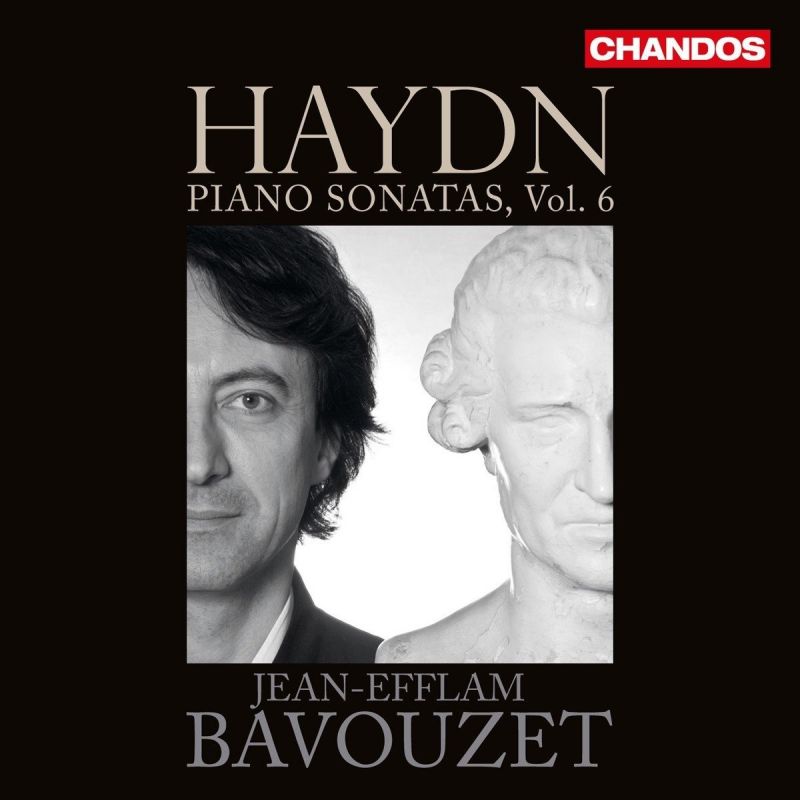HAYDN Piano Sonatas Vol 6
View record and artist detailsRecord and Artist Details
Composer or Director: Joseph Haydn
Genre:
Instrumental
Label: Chandos
Magazine Review Date: 06/2017
Media Format: CD or Download
Media Runtime: 83
Mastering:
DDD
Catalogue Number: CHAN10942

Tracks:
| Composition | Artist Credit |
|---|---|
| Sonata for Keyboard No. 11 (Parthia) |
Joseph Haydn, Composer
Jean-Efflam Bavouzet, Piano Joseph Haydn, Composer |
| Sonata for Keyboard No. 43 |
Joseph Haydn, Composer
Jean-Efflam Bavouzet, Piano Joseph Haydn, Composer |
| Sonata for Keyboard No. 35 |
Joseph Haydn, Composer
Jean-Efflam Bavouzet, Piano Joseph Haydn, Composer |
| Sonata for Keyboard No. 34 |
Joseph Haydn, Composer
Jean-Efflam Bavouzet, Piano Joseph Haydn, Composer |
| Sonata for Keyboard No. 36 |
Joseph Haydn, Composer
Jean-Efflam Bavouzet, Piano Joseph Haydn, Composer |
Author: Stephen Plaistow
Haydn’s reputation as a competent pianist but no wizard is surely correct; he appears never to have stepped forwards to present himself as a performer of his own solo pieces, and that probably accounts a good deal for the fact that they still live in the shadow of Mozart’s. Yet the piano was at the centre of his life, the instrument at which he improvised and tested all his ideas as part of his morning routine, and in writing music for it he was interested in the expressive possibilities that the developing fortepiano was opening up. The 60-odd sonatas represent some of the most ambitious keyboard music of their time, and virtuosity was always an element of it.
I’ve always loved it and have been admiring of Jean-Efflam Bavouzet’s Chandos series for promoting – in his description – ‘the boundless treasures of this sublime music’. He has done so at a level of technical perfection allied to insight, rigorous intellectual curiosity and the probing instincts of a distinguished performer that have never been brought to bear so acutely and consistently on this part of Haydn’s activity. Sometimes the music doesn’t look much on the page; some pianists regard the writing as relatively undeveloped, compared with Mozart’s or Clementi’s, and others have been perplexed by the fact that it doesn’t display a continuous stylistic development. Lay this baggage aside and listen to these five nicely programmed sonatas, none of which is often encountered in recitals. You catch Haydn’s adventurous spirit and humanity straight away; only he could have written them.
The B flat Sonata, HobXVI/2, is the earliest in this grouping and may date from 1762. It’s a lovely piece with a Largo second movement in G minor and a Trio section in B flat minor of the final Minuet that must have gladdened Brahms’s heart. Haydn at this time was reaping the harvest of his studies of Carl Philipp Emanuel Bach, the Treatise on the True Art of Keyboard Playing as well as CPE’s compositions. Haydn admired him as ‘the father of us all’.
In our turn we credit Haydn as the father of the symphony and the string quartet, yet we should not forget what he did for the piano sonata – neither Mozart nor Beethoven would have neglected to. The other four pieces here show his burgeoning range. The E flat Sonata No 28 explores brilliance and what the piano in the 1770s could inspire a composer to write; E flat minor appears for the Trio section of the Minuet, so fast-forward again to Brahms. Honour that man for championing his great predecessor when the 19th century had all but forgotten him. The closer one looks at No 43 in A flat, which appears at the outset to be content to please rather than astonish, the more characteristic it appears, with its pianissimo chords in a low register ending the first movement, the play of texture and sonority, the pauses, the little oppositions of sound and silence, the air of conversation and the bagatelle-like middle movement.
Faithful as always to Potton Hall in Suffolk, Bavouzet made the recording there last December. I had a moment of thinking the sound a mite clinical. I don’t think so now: wonderfully clean as his playing is, there is always warmth and a host of qualities that make his fingers sing and speak and entertain the way they do. There is nothing otiose or vacuous but he has the gift of making Haydn smile at us. With all repeats, the sonatas pan out at approximately 15 minutes each, which seems to me right. He is concerned that repeats should never be straightforward rhetorical formalities and varies them with an armoury of ornaments, mini-cadenzas and little textual ‘adjustments’. Better still, he knows when to stand back and do nothing. He writes about the why and wherefore of all this in the booklet.
The thicket of numerals attendant on any presentation of Haydn sonatas, thanks to the two divergent chronological numbering systems in use, is explained by Marc Vignal in another written contribution. Necessary to have, I daresay, but not compelling reading for most punters. Don’t let it put you off from getting to the music.Discover the world's largest classical music catalogue with Presto Music.

Gramophone Digital Club
- Digital Edition
- Digital Archive
- Reviews Database
- Full website access
From £8.75 / month
Subscribe
Gramophone Full Club
- Print Edition
- Digital Edition
- Digital Archive
- Reviews Database
- Full website access
From £11.00 / month
Subscribe
If you are a library, university or other organisation that would be interested in an institutional subscription to Gramophone please click here for further information.




